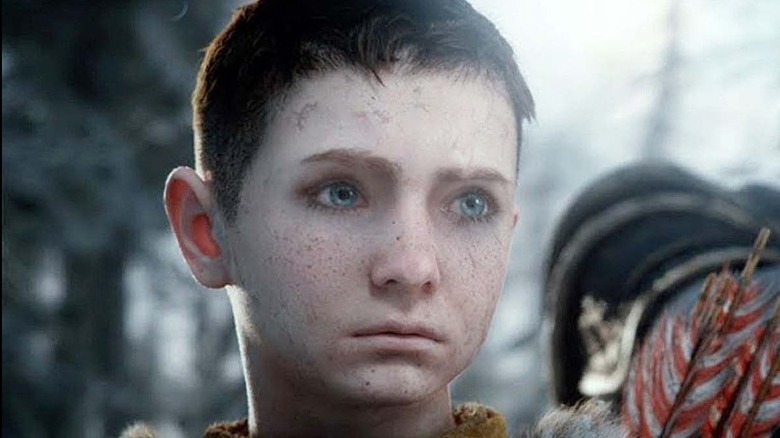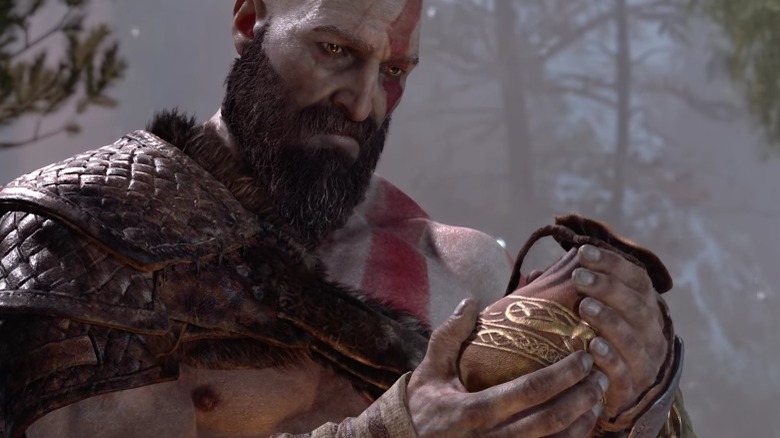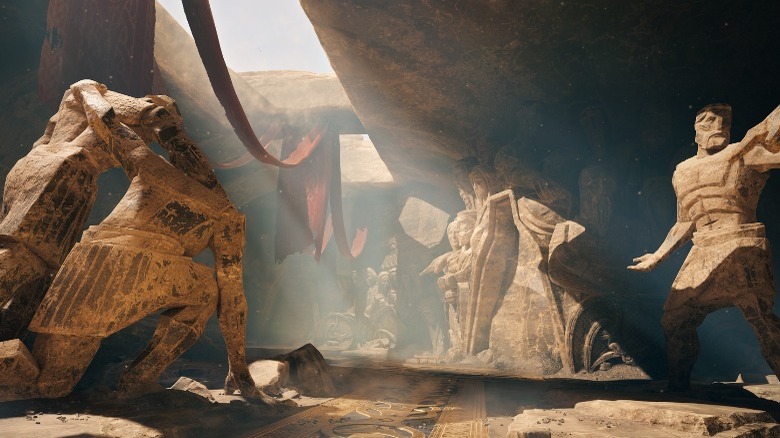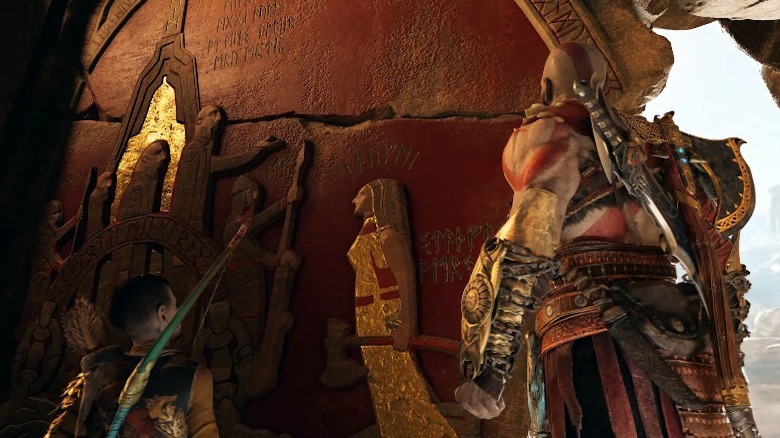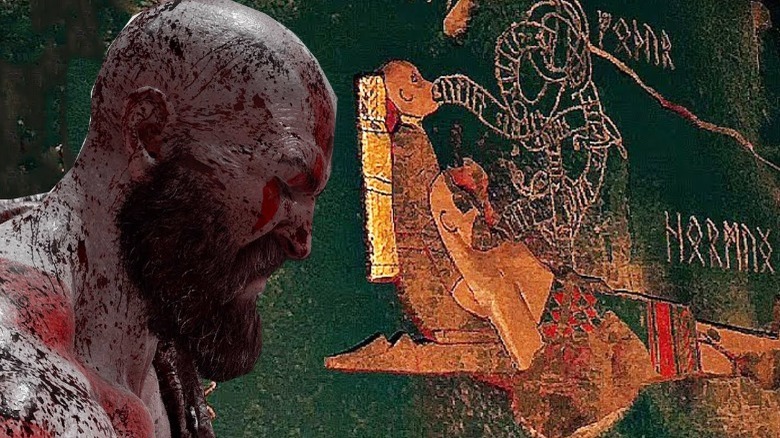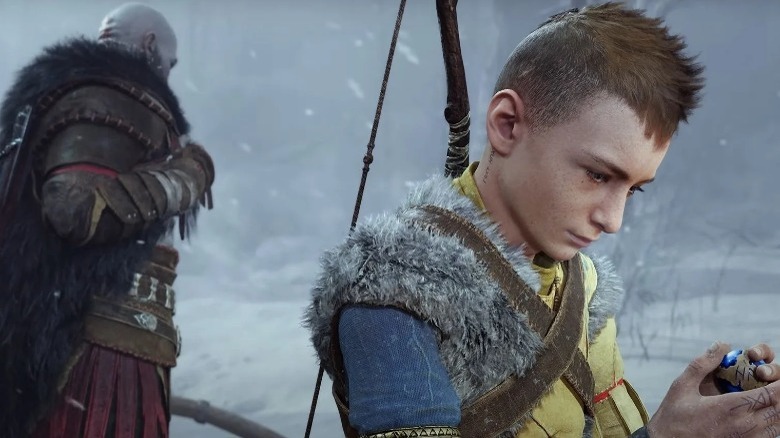God Of War Ending Explained
At a glance, "God of War" (2018) might seem like a fairly straightforward game about a shirtless man grunting as he swings an axe into giant monsters, but there's actually a surprisingly nuanced story buried underneath all the bravado. It builds upon the long and complicated timeline established in the original series while establishing a new beginning for Kratos after moving away from ancient Greece and starting a family. The narrative interweaves characters from both Greek and Norse mythology with several new characters of Santa Monica Studios' own creation.
"God of War: Ragnarok" is on its way and promises to be a game that will blow everyone away, but after suffering a delay, many fans may be turning back to the first game in the series reboot in order to get a taste of life in Midgard and see where the story began. Parts of this new chapter in Kratos' life can get a little hard to follow, however. While Santa Monica Studios pulls many aspects of its storylines from mythology, the storylines are original. So, it's easy for players to be confused by the somewhat convoluted ending which contains a revelation about Atreus' true identity. With that in mind, it's time to dive into one of the best games of 2018 and figure out what it all meant.
Carrying the ashes up the mountain
The game begins with Kratos chopping down a tree marked with a golden handprint for his deceased wife Faye's funeral pyre. When the ritual is complete, Kratos collects her ashes so that he and his son Atreus can set out to fulfill her final request, which was to have her remains scattered from the highest peak in the Nine Realms. This is the reason Kratos and Atreus leave their home in the first place. Figuring out why the Norse god Baldur is after them is really secondary. Delivering the ashes is the primary goal of their journey.
They initially set out to reach the tallest peak in Midgard, believing that this was the location she had in mind. An impossible barrier of black smoke created by Odin blocks their path, however. This is the point where the witch Freya appears and explains to them that there are nine realms, several of which Odin has made it impossible to travel to. She tells them that "only the pure light of Alfheim is strong enough to break through it" and reveals the secrets of how to travel between realms.
Traveling to Jötunheim
They eventually achieve their goal and reach the top of the mountain where they meet Mimir, the smartest man alive. Mimir has been imprisoned within a tree by Odin. Kratos and Atreus explain why they came and Mimir tells them that they have come to the wrong place. The highest peak is actually in Jötunheim, the realm of the giants. Kratos is confused and frustrated, stating "that could not be what she meant," but he and Atreus eventually acknowledge that this is where they need to go. Unfortunately, the giants destroyed all of the bridges to Jötunheim except one, which was locked with a secret rune. So Kratos and Atreus begrudgingly take Mimir's severed head so that he can serve as a guide to help them reach their destination.
Most of the rest of the game is spent attempting to attain a road to Jötunheim while battling through monsters and vengeful gods. They do reach the peak at the end, however, and this is where they discover a series of murals that reveal secrets about Faye and Atreus.
Who was Faye?
Upon reaching the peak of the mountain, Kratos and Atreus discover an abandoned temple built by the giants with depictions of their history. Atreus touches a wall and the outer surface crumbles away to reveal a series of murals underneath.
The first depicts a woman carrying the Leviathan Axe that the dwarves Brok and Sindri made for Faye and which Kratos has been using throughout the entire game. Atreus then states, "It's mother. Look, she's arguing with a bunch of giants. She knew giants?"
Atreus then examines several of the other murals and asks Kratos what the drawings mean, to which he replies, "that I was not the only parent with secrets." This is when Atreus realizes that his mother was a giant herself, meaning that he is half-god, half-giant. It was established early in the game that the term "giant" was the name of the race and did not actually refer to size, so Faye could have easily passed as a mortal.
Kratos then realizes that Faye intended for them to find this temple and these murals. He also realizes that Baldur was never interested in him, but was searching for Faye in order to eliminate the last giant in Midgard.
What does this mean for Atreus?
As Atreus examines the other murals, it becomes clear that they are not all depictions of the past. Several of them feature the events of their journey, including meeting the world serpent, fighting the dragon in the mountains, and their battle with Baldur. That means that these carvings were actually predictions of the future at the time that they were carved. This is why it is so unsettling when Kratos discovers a depiction of what appears to be a serpent coming out of Atreus' mouth and killing his Spartan father.
After spreading his mother's ashes, Atreus turns to Kratos and says, "I guess there's just one thing I don't understand. My name on the wall – the giants' called me Loki?" This of course should set off alarm bells for anyone familiar with Norse mythology (or Marvel for that matter,) as Loki is the name of the Norse god of mischief. Kratos then explains that Loki had been the name Faye wanted for him when he was born, but that Kratos had convinced her to name him Atreus after a Spartan soldier whom he had admired.
The Loki from Norse mythology was also the child of giants even though he was counted among the Aesir tribe of gods alongside Odin and Thor. The original Loki's mother was a giant named Laufey, which "Faye" may have been abbreviated from. Loki was also considered the cause of the Norse end of the world myth — Ragnarok.
What might this mean for God of War: Ragnarok
"God of War" games can be difficult to predict since they are not a direct retelling of the myths and legends that they take inspiration from. In the Norse myth, for example, Loki had three children with the giant Angerboda: Hel, the goddess of death, Jörmungand, the world serpent, and Fenrir the ever-growing wolf. In the game, however, Atreus is just a child, and Jörmungand is already fully grown. There still might be a few hints based on those myths as to what we might be able to expect in future "God of War" games, though.
For starters, the title of the sequel is called "Ragnarok," which means that the game will likely focus on several of the key events associated with that legend. According to Norse mythology, Loki was "fastened to three rocks in the cave with the entrails of his slain son, which the gods had turned into iron chains. Skadi placed a poisonous snake on a rock above his head, where it dripped venom onto his face. But Loki's faithful wife, Sigyn, sat by his side with a bowl that she held up to the snake's mouth to catch the poison ... until, as fated, Loki will break free from his chains at Ragnarok to assist the giants in destroying the cosmos." It seems possible that the mural where Kratos saw a snake coming out of his son's mouth and killing him was a reference to something similar.

